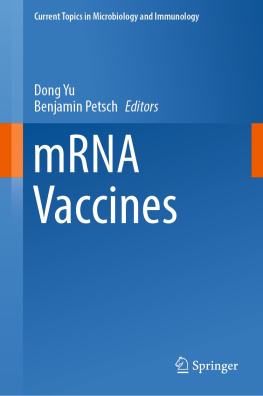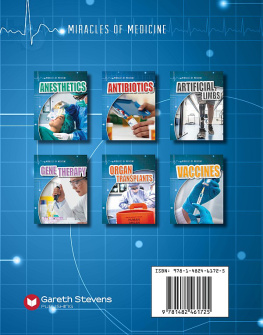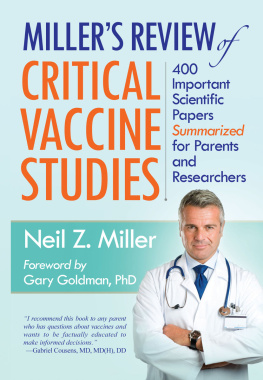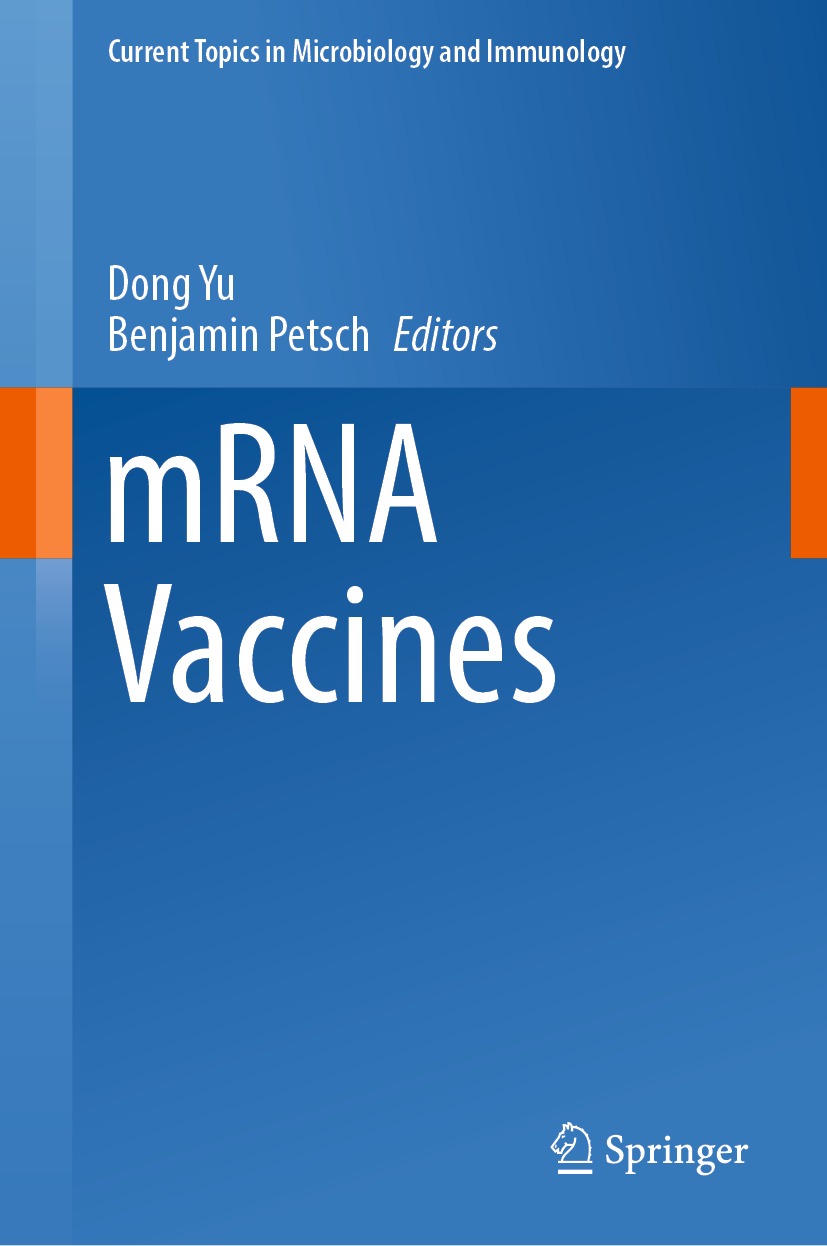Volume 440
Current Topics in Microbiology and Immunology
Series Editors
Rafi Ahmed
School of Medicine, Rollins Research Center, Emory University, Atlanta, GA, USA
Shizuo Akira
Immunology Frontier Research Center, Osaka University, Suita, Osaka, Japan
Arturo Casadevall
W. Harry Feinstone Department of Molecular Microbiology & Immunology, Johns Hopkins Bloomberg School of Public Health, Baltimore, MD, USA
Jorge E. Galan
Boyer Center for Molecular Medicine, School of Medicine, Yale University, New Haven, CT, USA
Adolfo Garcia-Sastre
Department of Microbiology, Icahn School of Medicine at Mount Sinai, New York, NY, USA
Bernard Malissen
Parc Scientifique de Luminy, Centre dImmunologie de Marseille-Luminy, Marseille, France
Rino Rappuoli
GSK Vaccines, Siena, Italy
The reviews series Current Topics in Microbiology and Immunology publishes cutting-edge syntheses of the latest advances in molecular immunology, medical microbiology, virology and biotechnology. Each volume of the series highlights a selected timely topic, is curated by a dedicated expert in the respective field, and contains a wealth of information on the featured subject by combining fundamental knowledge with latest research results in a unique manner.
2020 Impact Factor: 4.291, 5-Year Impact Factor: 5.110
2020 Eigenfactor Score: 0.00667, Article Influence Score: 1.480
2020 Cite Score: 7.7, h5-Index: 38
Editors
Dong Yu and Benjamin Petsch
mRNA Vaccines
Responsible Series Editor: Rino Rappuoli

Logo of the publisher
Editors
Dong Yu
Dynavax Technologies, Emeryville, CA, USA
Benjamin Petsch
CureVac AG, Tbingen, Germany
ISSN 0070-217X e-ISSN 2196-9965
Current Topics in Microbiology and Immunology
ISBN 978-3-031-18069-9 e-ISBN 978-3-031-18070-5
https://doi.org/10.1007/978-3-031-18070-5
Springer Nature Switzerland AG 2022
This work is subject to copyright. All rights are reserved by the Publisher, whether the whole or part of the material is concerned, specifically the rights of translation, reprinting, reuse of illustrations, recitation, broadcasting, reproduction on microfilms or in any other physical way, and transmission or information storage and retrieval, electronic adaptation, computer software, or by similar or dissimilar methodology now known or hereafter developed.
The use of general descriptive names, registered names, trademarks, service marks, etc. in this publication does not imply, even in the absence of a specific statement, that such names are exempt from the relevant protective laws and regulations and therefore free for general use.
The publisher, the authors, and the editors are safe to assume that the advice and information in this book are believed to be true and accurate at the date of publication. Neither the publisher nor the authors or the editors give a warranty, expressed or implied, with respect to the material contained herein or for any errors or omissions that may have been made. The publisher remains neutral with regard to jurisdictional claims in published maps and institutional affiliations.
This Springer imprint is published by the registered company Springer Nature Switzerland AG
The registered company address is: Gewerbestrasse 11, 6330 Cham, Switzerland
Preface
What a difference the recent two years have made for mRNA technology, particularly in the field of vaccines! mRNA is the intermediate transcribed from coding DNA and translated into proteins by the host cell. In principle, the mRNA technology is rather straightforward. An mRNA molecule encoding a vaccine antigen is generated by in vitro transcription, formulated with a synthetic delivery vehicle, such as lipid nanoparticles (LNPs), and delivered to the target cells of the host. The antigen is translated from the delivered RNA by the host cell and elicits innate and antigen-specific adaptive immune responses to protect against the targeted pathogen. To date, two major forms of mRNA vaccines have currently been developed: conventional mRNA mimicking endogenous RNAs (The chapter ). The first report of using in vitro transcribed mRNA to express a reporter gene in animals was published in the 1990s, and the mRNA vaccine field has been advancing rapidly since then. Over the last 20 years, there has been increasing interest in the application of mRNA-based technology for the development of vaccines against infectious diseases and other disease targets. In parallel, tremendous progress has been made to make the mRNA technology amenable to these applications. A large body of proof-of-concept data has been accumulated in preclinical animal models, followed by multiple clinical trials that have generated promising data over the past several years. Companies such as CureVac, Novartis/GSK, Moderna, and BioNTech paved the way in both technology innovation and clinical development of mRNA-based vaccines. However, it was not until 2019, when the COVID-19 pandemic occurred, that the mRNA vaccine technology entered a new era. In collaboration with leading vaccine researchers, BioNTech/Pfizer and Moderna successfully developed two highly effective SARS-CoV-2 vaccines, namely Comirnaty and SpikeVax, in record time. These vaccines have saved countless lives from severe COVID-19 illness and death and now have been fully approved across multiple age cohorts by FDA and EMA. With the success of these two vaccines, the use of the mRNA platform for a rapid response to emerging infectious diseases and outbreaks and for scale up of manufacturing has been truly appreciated, and the utility of this platform to produce highly effective vaccines has been fully materialized.
This book series reviews both mRNA platforms, the conventional mRNA-based and the virally derived self-amplifying mRNA. The advancements in RNA biology, chemistry, stability, and delivery that have enabled the development of fully synthetic mRNA vaccines are discussed. Applications of the RNA technology are covered, focusing on infectious disease vaccines, but also other applications are reviewed , such as immunotherapies and molecular therapies. Potent and long-lasting immune responses observed in animal and early human studies, importantly, together with the most recent success of two SARS-CoV-2 mRNA vaccines, support the potential of mRNA-based vaccination as a major alternative to conventional vaccine approaches. Consequently, the clinical development, regulatory issues, and remaining challenges unique to the mRNA vaccination approach are reviewed.
In the chapter of , Gergen et al. provide insight into the function and optimization of key elements of a mRNA vaccine molecule (e.g., CAP-structure, 5 and 3 UTRs, 3 end of the mRNA, and codon usage). The use of modified nucleotides, which is the foundation of the two licensed SARS-CoV-2 mRNA vaccines, is being discussed. The chapter offers an in-depth review on the effect of innate recognition of mRNA molecules on their immunogenicity (humoral and cellular), potency, and reactogenicity. The chapter concludes with a summary on the recent advancements and opportunities to further improve the existing technology. Nonetheless, with the launch of SARS-CoV-2 vaccines, the field has progressed at an unprecedented speed and the amount of data generated in humans using the licensed mRNA vaccines could not be fully captured in this chapter. These new progresses will be the subject of subsequent reviews.










